
I'd Rather Be Right is a 1937 musical with a book by Moss Hart and George S. Kaufman, lyrics by Lorenz Hart, and music by Richard Rodgers. The story is a Depression-era political satire set in New York City about Washington politics and political figures such as President Franklin D. Roosevelt. The plot centers on Peggy Jones and her boyfriend Phil, who needs a raise in order for them to get married. The President steps in and solves their dilemma.

Sunrise at Campobello is a 1960 American biographical film telling the story of the struggles of future President of the United States Franklin D. Roosevelt and his family when Roosevelt was stricken with paralysis at the age of 39 in August 1921. Based on Dore Schary's 1958 Tony Award-winning Broadway play of the same name, the film was directed by Vincent J. Donehue and stars Ralph Bellamy, Greer Garson, Hume Cronyn and Jean Hagen.

Isadore "Dore" Schary was an American playwright, director, and producer for the stage and a prolific screenwriter and producer of motion pictures. He directed one feature film, Act One, the film biography of his friend, playwright and theatre director Moss Hart. He became head of production at Metro-Goldwyn-Mayer and replaced Louis B. Mayer as president of the studio in 1951.
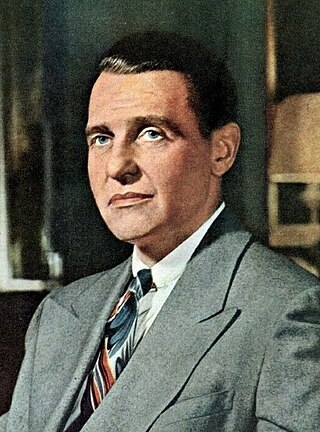
Ralph Rexford Bellamy was an American actor whose career spanned 65 years on stage, film, and television. During his career, he played leading roles as well as supporting roles, garnering acclaim and awards, including a Tony Award for Best Actor in a Play for Sunrise at Campobello as well as Academy Award for Best Supporting Actor nomination for The Awful Truth (1937).
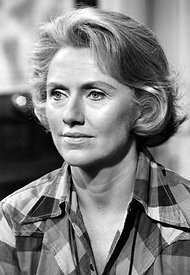
Mary Fickett was an American actress with roles in the American television dramas The Nurses, The Edge of Night as Sally Smith (1961) and Dr. Katherine Lovell (1967–68), and as Ruth Parker Brent Martin #1 on All My Children.

Warm Springs is a 2005 made-for-television biography drama film directed by Joseph Sargent, written by Margaret Nagle, and starring Kenneth Branagh, Cynthia Nixon, Kathy Bates, Tim Blake Nelson, Jane Alexander, and David Paymer. The screenplay concerns U.S. President Franklin D. Roosevelt's 1921 illness, diagnosed at the time as polio, his struggle to overcome paralysis, his discovery of the Warm Springs resort, his work to turn it into a center for the rehabilitation of polio victims, and his resumption of his political career. Roosevelt's emotional growth as he interacts with other disabled people at Warm Springs prepares him for the challenges he will face as president during the Great Depression.

Sara Ann Roosevelt was the second wife of James Roosevelt I, the mother of Franklin Delano Roosevelt, the 32nd President of the United States and her only child, and subsequently the mother-in-law of Eleanor Roosevelt.
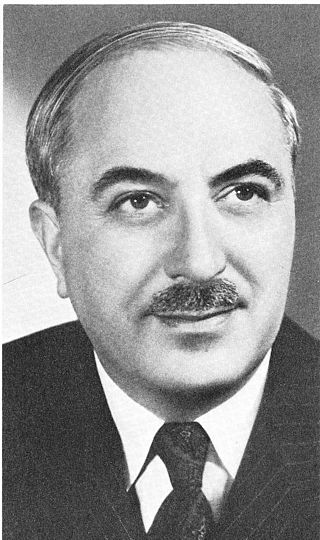
Lawrence Langner was a playwright, author, and producer who also pursued a career as a patent attorney.

Ann Shoemaker was an American actress who appeared in 70 films and TV movies between 1928 and 1976. She portrayed Sara Roosevelt, mother of Franklin D. Roosevelt, in both the stage and film versions of Sunrise at Campobello.

Roosevelt Campobello International Park preserves the house and surrounding landscape of the summer retreat of Franklin D. Roosevelt, Eleanor Roosevelt and their family. It is located on the southern tip of Campobello Island in the Canadian province of New Brunswick, and is connected to the mainland by the Franklin Delano Roosevelt Memorial Bridge, at Lubec, Maine in the United States.

Henry Burk Jones was an American actor of stage, film, and television.
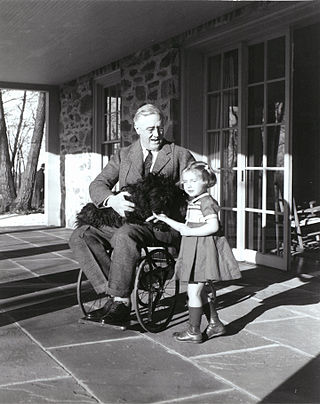
Franklin D. Roosevelt, later the 32nd president of the United States from 1933 to 1945, began experiencing symptoms of a paralytic illness in 1921 when he was 39 years old. His main symptoms were fevers; symmetric, ascending paralysis; facial paralysis; bowel and bladder dysfunction; numbness and hyperesthesia; and a descending pattern of recovery. He was diagnosed with poliomyelitis and underwent years of therapy, including hydrotherapy at Warm Springs, Georgia. Roosevelt remained paralyzed from the waist down and relied on a wheelchair and leg braces for mobility, which he took efforts to conceal in public. In 1938, he founded the National Foundation for Infantile Paralysis, leading to the development of polio vaccines. Although historical accounts continue to refer to Roosevelt's case as polio, the diagnosis has been questioned in the context of modern medical science, with a competing diagnosis of Guillain–Barré syndrome proposed by some authors.

Eleanor and Franklin is a 1976 American television miniseries starring Edward Herrmann as Franklin D. Roosevelt (FDR) and Jane Alexander as Eleanor Roosevelt which was broadcast on ABC on January 11 and 12, 1976. It is the first part in a two-part "biopic" miniseries based on Joseph P. Lash's biography and history from 1971, Eleanor and Franklin, based on their correspondence and recently opened archives. Joseph Lash was Eleanor's personal secretary and confidant. He wrote several books on the Roosevelts including some on both Eleanor and Franklin individually and was also a controversial activist in his own right in leftist, liberalism, social and labor issues of the era.
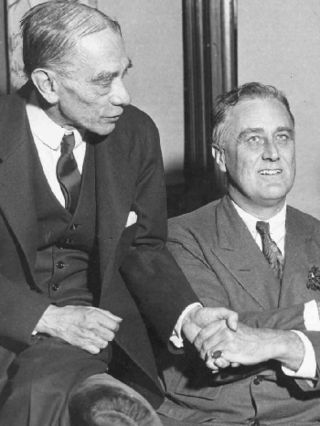
Louis McHenry Howe was an American reporter for the New York Herald best known for acting as an early political advisor to President Franklin D. Roosevelt.
A Majority of One is a play by Leonard Spigelgass. The 1958-59 Broadway production was directed by Dore Schary and ran for three previews and 556 performances, with Gertrude Berg, Cedric Hardwicke, and Ina Balin.

James Earl Jones was an American actor. A pioneer for black actors in the entertainment industry, he is known for his extensive and acclaimed roles on stage and screen. Jones is one of the few performers to achieve the EGOT. He was inducted into the American Theater Hall of Fame in 1985, and was honored with the National Medal of Arts in 1992, the Kennedy Center Honor in 2002, the Screen Actors Guild Life Achievement Award in 2009, and the Academy Honorary Award in 2011.
Ralph Alswang was an American theatre and film director, designer, and producer. He designed scenery, lighting, and costumes for nearly 100 Broadway productions. He also designed venues such as the George Gershwin Theatre.
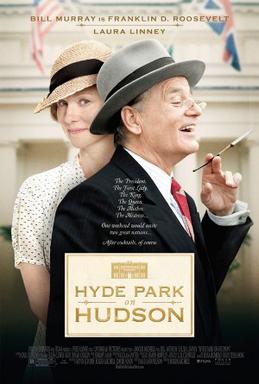
Hyde Park on Hudson is a 2012 historical drama film directed by Roger Michell. The film stars Bill Murray as Franklin D. Roosevelt, Samuel West as King George VI, Olivia Colman as his wife Queen Elizabeth and Laura Linney as Margaret "Daisy" Suckley, a cousin and childhood friend of the President. It was based on Suckley's private journals and diaries, discovered after her death and fictionally dramatizes her close relationship with Roosevelt and the 1939 visit of King George VI and Queen Elizabeth to Roosevelt's country estate.
Don Gregory was an American Broadway producer.
Franklin D. Roosevelt, the 32nd President of the United States, has inspired or been portrayed in numerous cultural works.
















